The concrete canvas
A look at how the city paints Winnipeg's streets
Advertisement
Read this article for free:
or
Already have an account? Log in here »
To continue reading, please subscribe:
Monthly Digital Subscription
$19 $0 for the first 4 weeks*
- Enjoy unlimited reading on winnipegfreepress.com
- Read the E-Edition, our digital replica newspaper
- Access News Break, our award-winning app
- Play interactive puzzles
*No charge for 4 weeks then billed as $19 every four weeks (new subscribers and qualified returning subscribers only). Cancel anytime.
Read unlimited articles for free today:
or
Already have an account? Log in here »
Hey there, time traveller!
This article was published 29/05/2015 (3247 days ago), so information in it may no longer be current.
The roads of Winnipeg take a beating every winter, from the layers of sand to the scraping of snowplows. Then, when the snow melts away, an empty canvas is revealed, one where lane markings have been scrubbed clean.
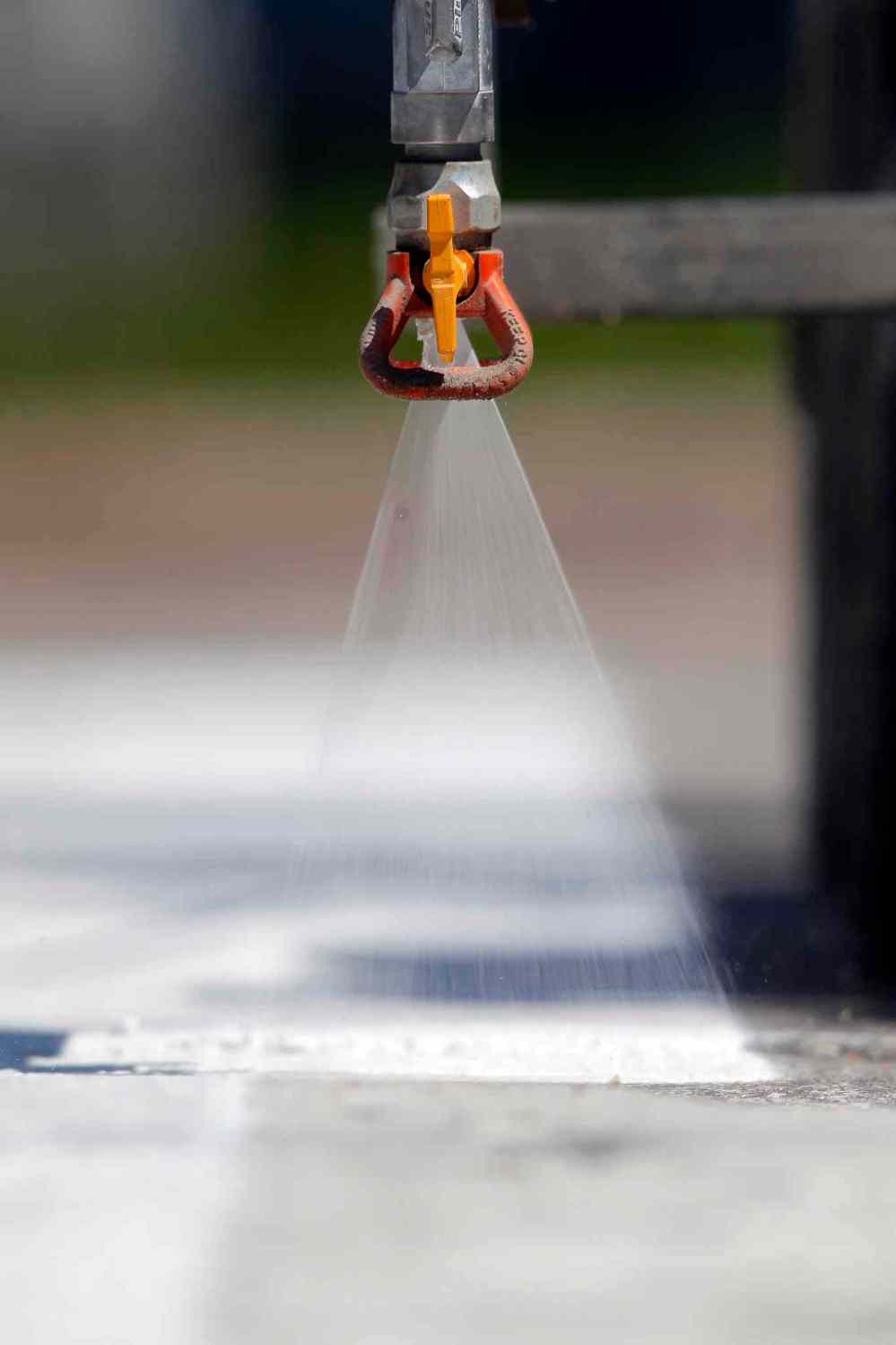
Figuring out where one lane ends and the next begins is Winnipeg’s own version of the video game Frogger.
Eventually a team of city workers makes its way across Winnipeg and paints over the faded lines, creating a motorist’s masterpiece, where each lane, intersection and bike route is clearly marked.
Then winter arrives, erasing their hard work. Come spring, they are back it again.
The Free Press set out to examine this annual ritual, by meeting the crews behind the scenes and examining the reality of why Winnipeg’s lane markings disappear.
And raising the question: is there not a better way?
The short answer? Yes.
The long answer? It’s a lot more complex.
The nuts and bolts
The city is responsible for painting about 1,000 kilometres of road and 1,061 intersections every year, usually once in the spring and again in the fall. Heavy-volume roads such as Main Street or Portage Avenue are often painted three times a year.
Winnipeg’s disappearing lane markings are just another product of our harsh winter climate, explains the city’s superintendent of traffic services.
Wes Delaney, who has devoted most of his professional life to organizing lane-painting in some capacity, probably understands the science that goes into painting roads and highways better than most Manitobans.
“Our climate here sucks for painting. We have a short window to get all this done by November and then, of course, the snow hits and the sanders are out — that is the worst thing for the road paint: the sand,” he says. “It is sandpaper grinding it off all winter long, until there is nothing left and then the plows come out and rip it all up.”
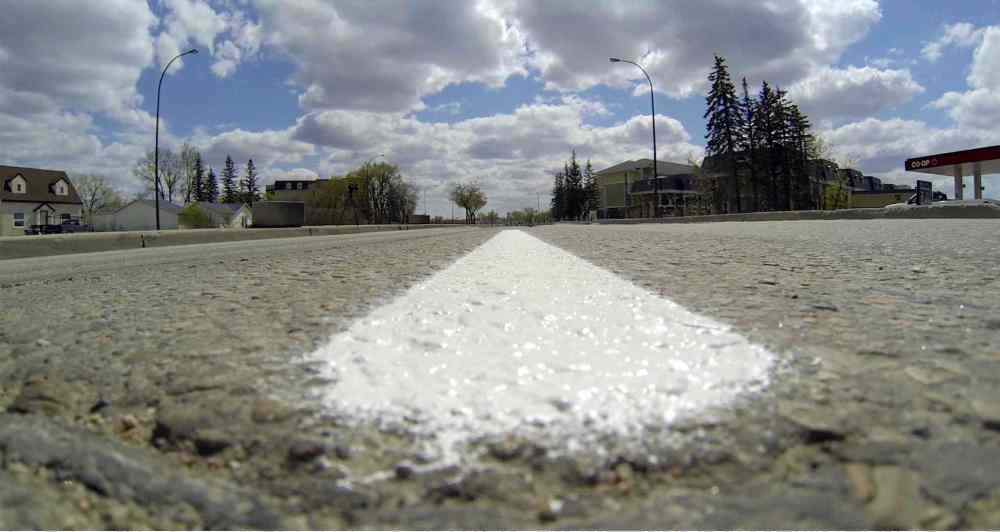
Also, the snow-clearing practice of scraping right to the concrete plays a role, he explains.
Like most cities in North America, Winnipeg uses a quick-dry alkyd paint, and what it lacks in durability, it makes up for in low price.
With the current technology and a crew of three workers, the city can do about 10 kilometres an hour, at a cost of about 38 cents a metre for the paint.
It has an annual budget of about $1.1 million and goes through 66,700 litres of paint.
The city tried to experiment with latex paint, which is slightly cheaper and what the province typically uses for its highways; however, the constant criss-crossing traffic created a mess of the roads, Delaney says.
The city has one truck devoted to the task. It operates throughout the spring and summer, four days a week, once it gets warm enough for the paint to stick.
Since May 4, city crews have been out in full force, beginning with priority routes such as high-traffic parts of Main Street or Pembina Highway and bridges such as Provencher. Next up are the Priority 2 roads, including Henderson Highway and the downtown core, before the rest of the city’s major and minor roads are tackled. It takes the crew until June just to finish the Priority 1 roads.
Three times between May 4 and November, Winnipeggers will see the crew back at Main Street and other high-traffic stretches, painting them again and again, in hopes the lines will survive the winter.
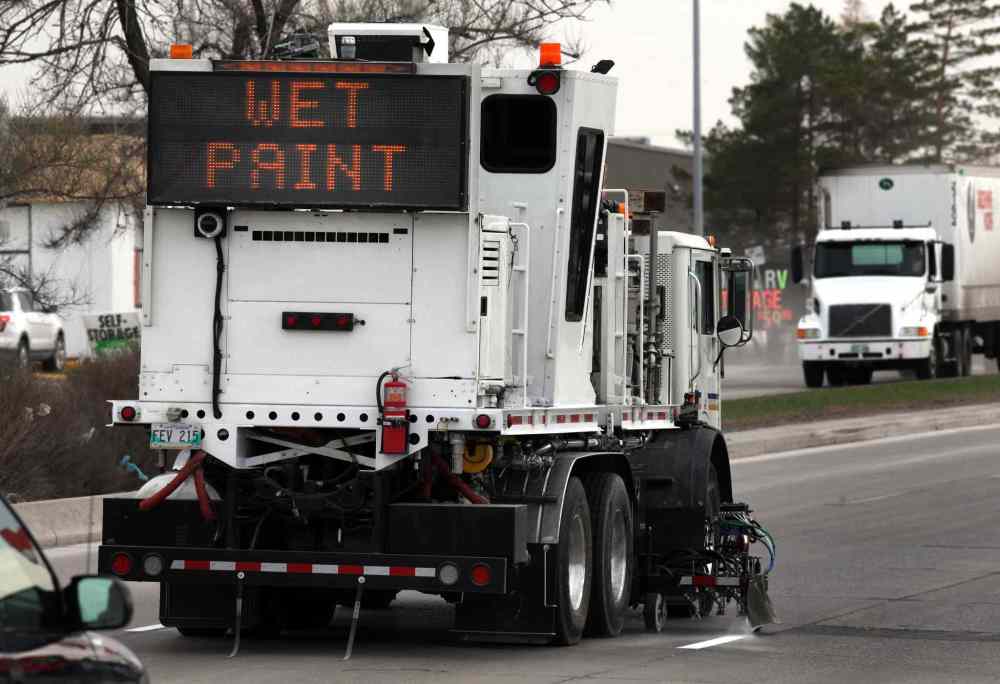
The crew
At first glance, it looks as if only one worker, driving a large truck with two paint guns attached, is responsible for marking Winnipeg’s streets.
But it takes more precision and manpower than that.
The driver is more like an air-traffic controller to the two “pilots” who are hidden in the back compartment and who make sure the solid lines are painted solid, the dotted lines are dotted and the yellow paint goes where it should go.
They are the artists of the roads you drive every day.
And some, such as Frank Warenko, have been around for a decade, repainting the same streets every year, sometimes two or three times.
“Ten years too long — the grey is starting to come from onto the road and into the hair,” the veteran lane-liner operator jokes, one eye focused on the live camera in front of him, letting him know what is ahead.
Warenko eases through the job of painting a stretch of Pembina Highway, paint throttle in hand, listening through his headset as the crew chief warns him of shifts in the road up ahead.
The truck uses a laser to line up with existing lanes, allowing the crew to put down a fresh new coat, with colour, thickness and length based partially on their institutional knowledge and partially on the warnings of the crew chief.
Only a foot separates Warenko and his lane-painting partner Bruce Evans in the cramped back cab, where the large computer system takes up most of the space.
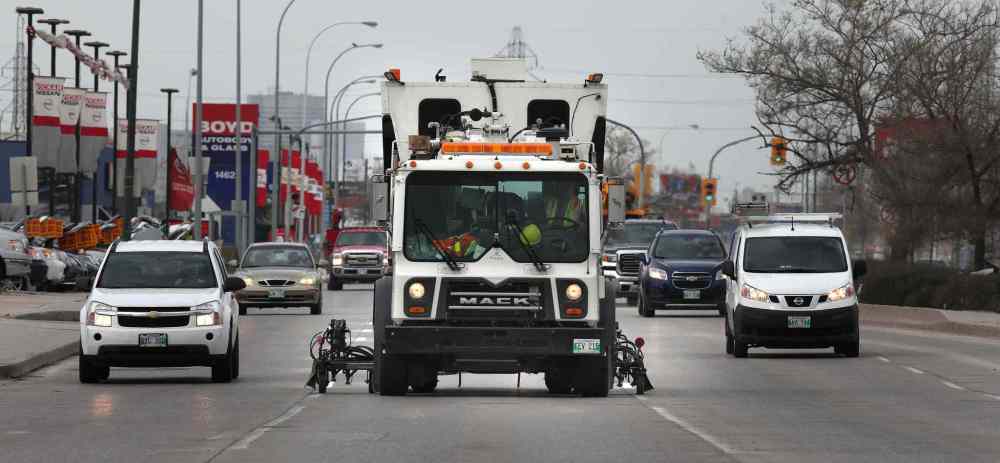
“It is all automatic; we have three computers and everything is set by it and you adjust it by values and measures,” Warenko says.
The truck travels about 20 kilometres an hour, as Corey Bakker, the driver and crew chief, warns Warenko and Evans of upcoming changes, such as a switch from a dotted to solid line.
Warenko then turns to his computer in front of him and chooses from multiple options — dotted, yellow, bus lanes, bike paths or double lines — with the turn of dial.
Meanwhile, their live cameras can switch from viewing the road ahead or to looking behind at the completed work.
Bakker has the lane painter’s bible, a detailed book that can tell him at a glance what colour to use, whether it is a regular lane, a bike lane or a specialty turning lane. It is his job to relay the information to the crews in the back, to make sure the concrete canvas is painted properly.
Once it’s the proper road temperature — the paint guns won’t even fire until it’s in the range — and they have reached the right spot in the road, Bakker radios to Warenko that the magic is about to begin.
“Now,” Warenko says, partially to himself, but also to Evans and Bakker.
The system is similar to the way the city’s sanding trucks work, but in this case, it monitors paint and bead levels.
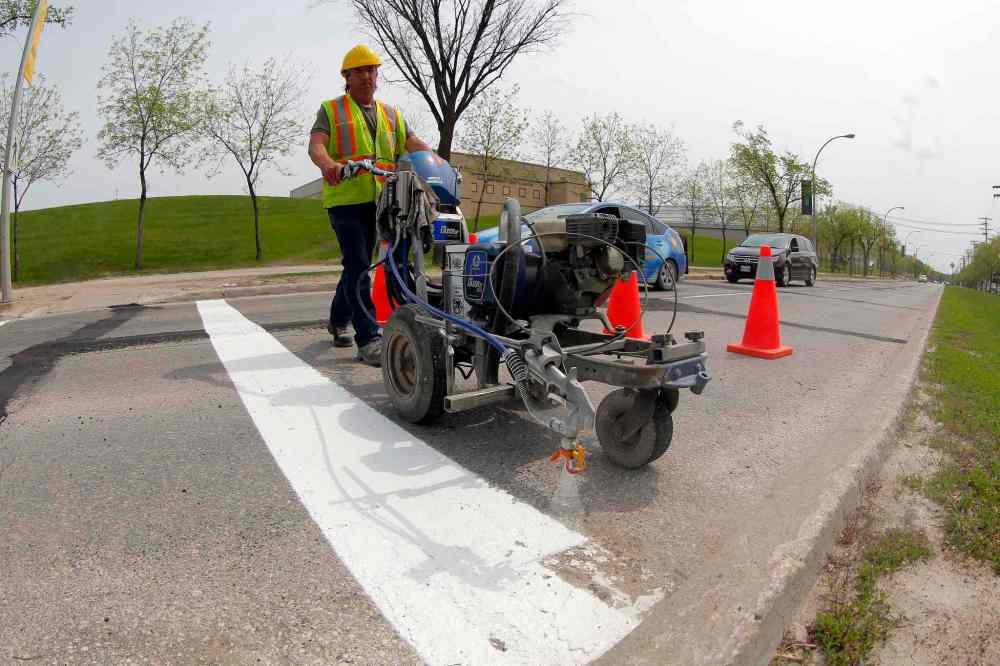
Time-delayed glass beads are released after the paint comes out. This gives Winnipeg’s roads their reflective quality — crucial for nighttime visibility.
Winnipeg goes through more than 4,000 kilograms of these beads in a year.
The paint truck is the only one the city owns and Warenko, Bakker, Evans and Delaney dream of the day the city invests in a second machine.
At over $500,000, it is an expensive investment, but a wise one, Delaney says.
“We could just get into the city and do a lot of places all at once,” he says. “We could have one crew in one area, and one doing the other.”
A second truck would also cut down on the number of complaints he receives, because it would take less time after the spring melt to get the job done.
It takes the crews about 24 weeks to complete the entire process, including eight to 10 weeks just to paint the city’s intersections.
A better way?
It costs the city $1,100 per kilometre of road it paints every year, a number that will continue to climb as Winnipeg grows.
Some cities, such as Calgary and Saskatoon, are experimenting with more durable markings, tape and inlaid thermoplastic that will survive winter’s sand and snow to remain on roads for years at a time.
However, the cost difference is astronomical, Delaney says.
Saskatoon set out to find just how astronomical the difference is between painting annually versus choosing a durable option that can last five or 10 years.
Using a 10-year estimate, the city determined it would cost at least double for a 10-year inlaid thermoplastic or five-year plastic durable marking, compared with painting each year.
Despite that, the city decided to double its durable-paint budget to $500,000 and is doing 27 kilometres of durable five-or 10-year marking this year, targeting its arterial roads.‘The big advantage is from a safety perspective. Drivers can clearly delineate between the lines, year-round.’
— Angela Gardiner, on more durable line markings
Angela Gardiner, manager of Saskatoon’s transportation branch, says it was not a hard decision — because you can’t put a price on increasing residents’ safety.
“The big advantage is from a safety perspective. Drivers can clearly delineate between the lines, year-round,” she says. “It is difficult to put a cost on a collision; there is a definitely a benefit to continue to expand.”
The city will be focusing on various roads and freeway entrances, but it must factor in the city’s road-repair plan, too, because it makes little sense to put a five-year marking on a road that is going to be torn up, she says.
“It is a bit of a puzzle putting all this together,” Gardiner says.
The year-round safety benefits, compared with less disruption to traffic each year, all make switching away from paint an easy-sounding solution, other than the money factor, Delaney says.
“It is in the millions, I have never even thought it out yet. But it would astronomical,” he says. “If we had the budget to do that, we would definitely do it.”
It is not just the price per kilometre, but also the intense labour costs involved with either going with a tape or thermoplastic. It would require either several new, expensive trucks or having crews shut down entire sections of roads while they apply the tape manually.
In a 2013 trial, a three-kilometre stretch of Pembina Highway south of Bishop Grandin Boulevard was lined with 3M tape, a durable marking that can last about five to seven years.
It is holding up well, so far.
However, it took about four days to lay down the tape, versus the 20 minutes it would take to paint the same section.
The city plans to extend this stretch of 3M tape by a further one to three kilometres this summer.
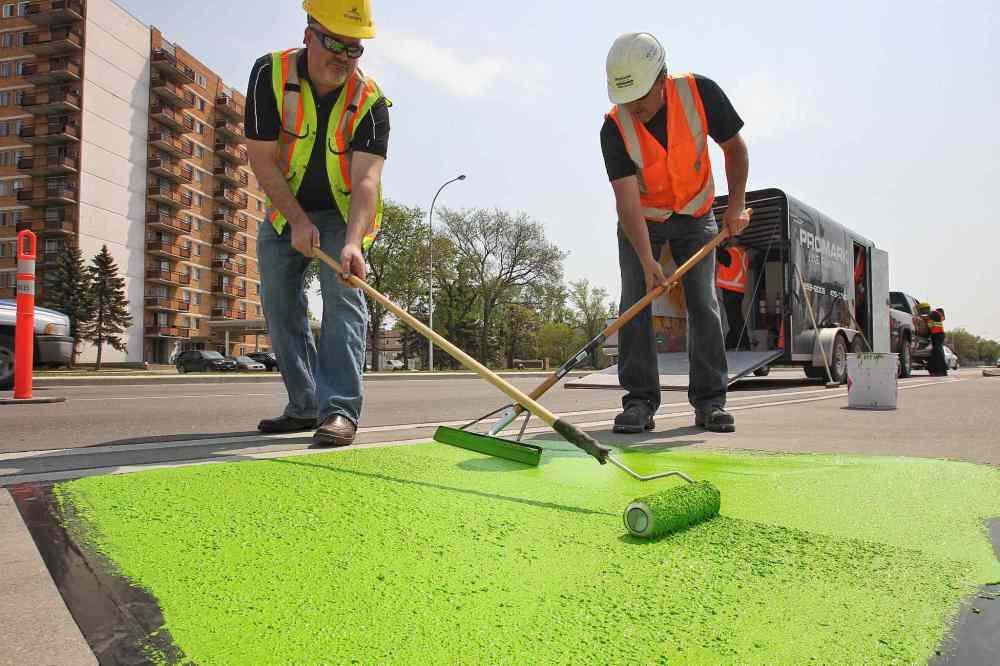
Also, about one kilometre on Pembina Highway, north of Bishop Grandin, is being tested with methyl methacrylate (MMA) paint, a more durable paint similar to the epoxy paint used by Calgary that lasts five years.
This week, crews returned to Pembina Highway to further test using MMA by painting a 20-foot green bike path marker near Chancellor Drive. The cost? About $1,000.
Eventually, the hope is to use the MMA paint on bicycle lanes downtown, Delaney says. The MMA paint is highly visible — about eight times the reflectiveness of regular paint — and provides added traction for bike tires. “We are going to test it for the summer to see how it pans out and holds up.”
If the budget allowed for it, Delaney says he would “love” to see heavily travelled roads such as Main Street outfitted with 3M tape.
“It’d be great, especially because it is new concrete along Main Street, so the paint really doesn’t stick,” Delaney says. “It is always there for you. That is what you want — it is there in spring, summer, winter.”
In cities where there is less snow, such as Hamilton, road paint tends to last longer, but officials there are still keeping an eye on a more practical solution.
Kris Jacobson, Hamilton’s superintendent of traffic operations, says there is a knowledge gap when it comes to installing and maintaining durable markings in a cost-effective manner.
“We are beginning to see that the costs are starting to come in line. (But) is the technology advancing to the point where it does make sense to do this? Pricing, expertise with the equipment is starting to get there,” he says.
“Probably in the next couple of years, we will see a shift and it will become more cost effective.”
A spokeswoman for CAA Manitoba says they are supportive of using more durable paint, so drivers are better able to “follow the rules of the road.”
“It could help cut down on driver frustration, confusion and preventable accidents,” Liz Kulyk says.
“This may mean a larger upfront investment, but if it means lines are visible all year and don’t have to be repainted as often, it’s something CAA would support.”
Coun. Janice Lukes, the chairwoman for the city’s public works committee, agrees the stretch of her ward on Pembina Highway looks great and is much better for motorists.
However, the St. Norbert councillor believes Winnipeggers want to see their roads repaired before the city spends the money on durable paint.
Once the city gets a better handle on its infrastructure deficit, she fully supports moving towards more durable markings on the arterial roads.
“You give a person a choice: do you want a nicely painted road or do you want a road that actually functions? You are going to want a road that functions,” she says.
“Right now, where this city is at with infrastructure, I would hazard to say that having functional roads, not full of potholes, is more important than inlaid paint on the road.”
kristin.annable@freepress.mb.ca


